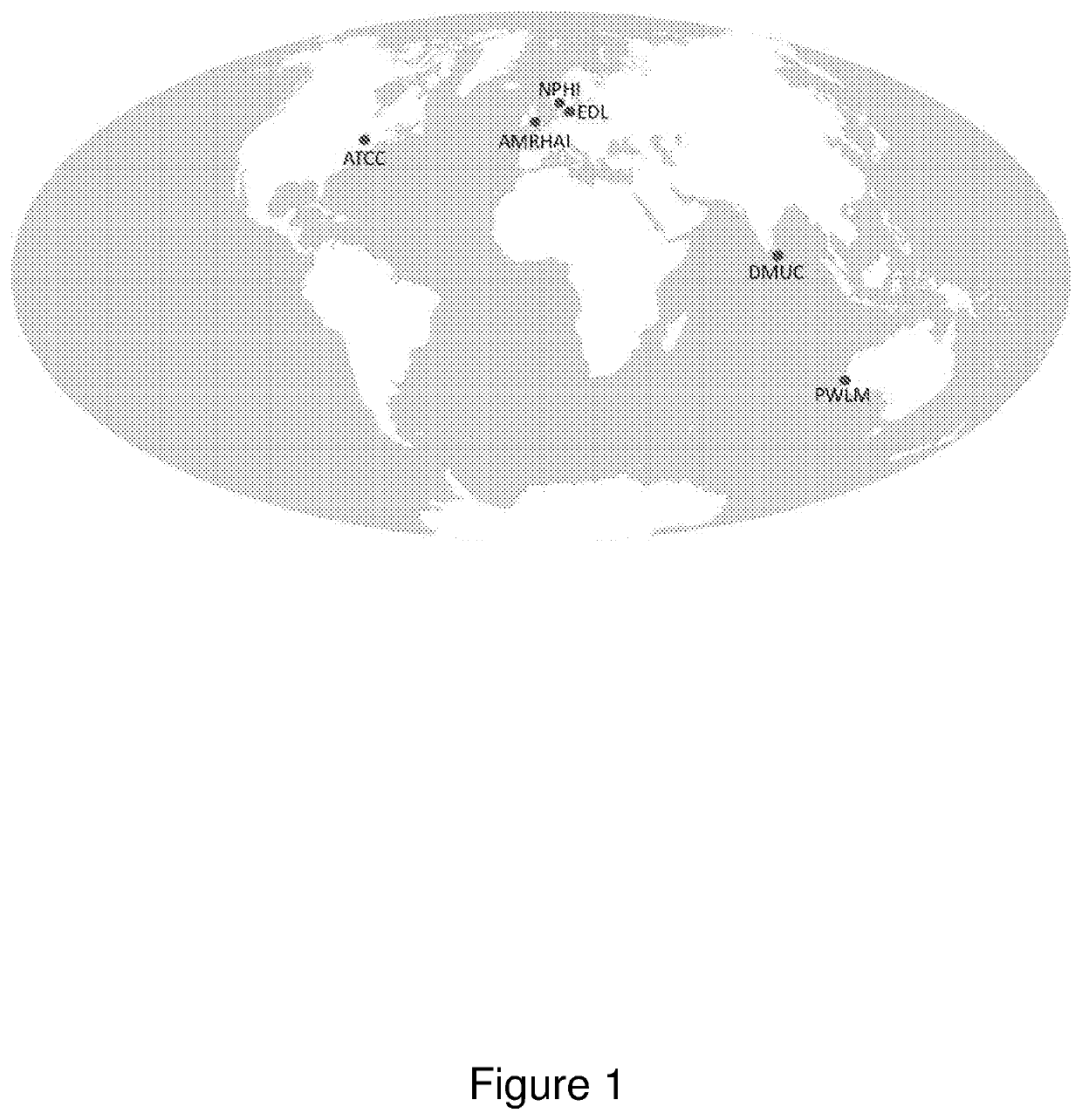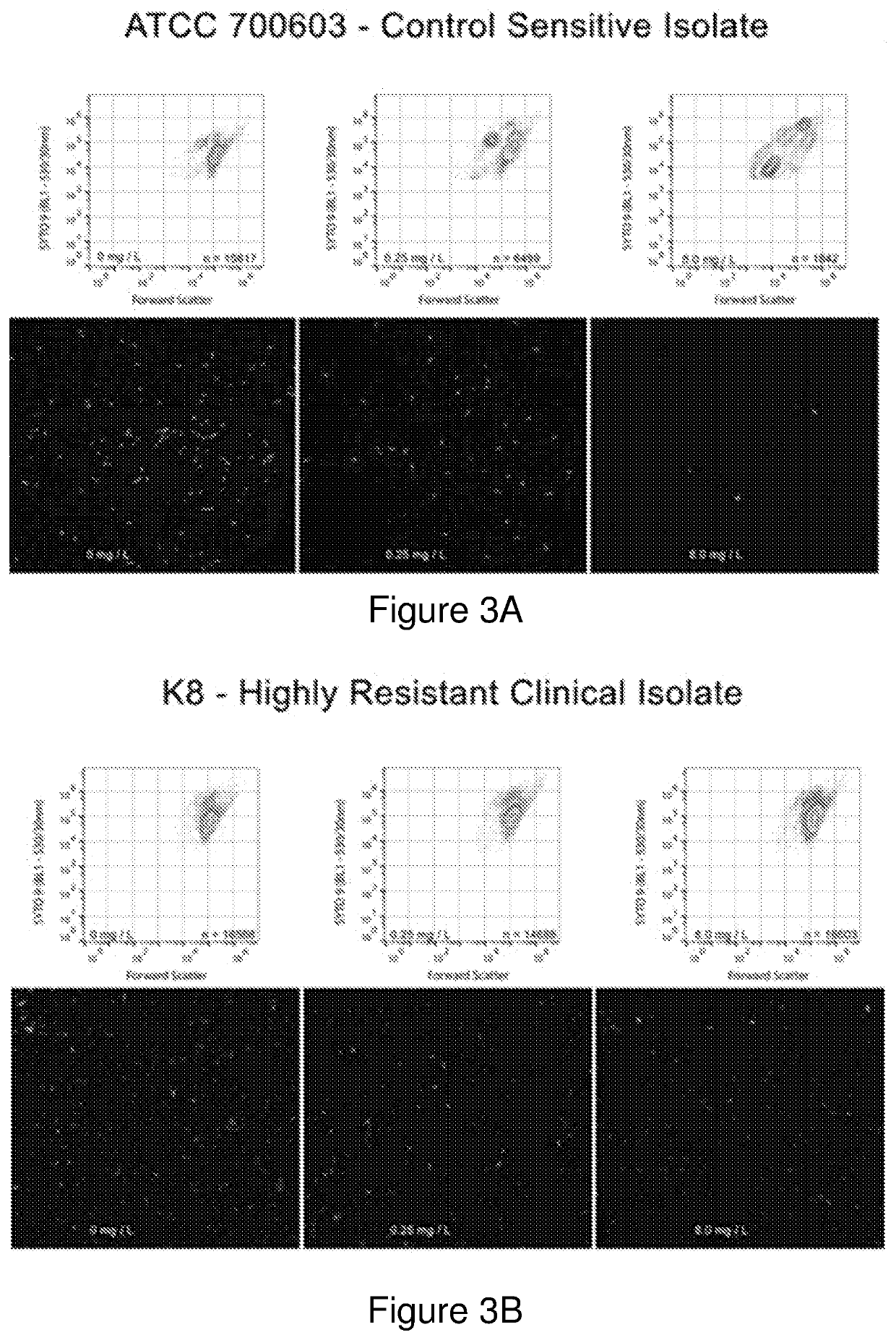Method for testing antimicrobial susceptibility
a technology of susceptibility and quantitative determination, applied in the field of quantitative determination of the susceptibility of microbial organisms, can solve the problems of inability to empirically test, time-consuming laboratory techniques for determining the susceptibility of microorganisms to antimicrobial agents, and widespread threat to the public, so as to achieve rapid determination of carbapenem susceptibility and antimicrobial susceptibility
- Summary
- Abstract
- Description
- Claims
- Application Information
AI Technical Summary
Benefits of technology
Problems solved by technology
Method used
Image
Examples
example 1
Isolates
[0489]This example demonstrates assembly of a representative panel of known isolates of a microorganism to which MICs of antimicrobial agents are known. The representative panel can be used as a reference or standard for rapid determination of MICs from output data obtained by acoustic flow cytometry methods of the invention.
[0490]This example also demonstrates assembly of a representative panel of known isolates of a microorganism for validating susceptibility classification and susceptibility testing results obtained with the acoustic flow cytometry methods of the invention, against broth microdilution analysis to demonstrate effectiveness of the method of the present invention.
[0491]An internationally representative panel of 48 carbapenemase-producing Klebsiella isolates covering a susceptibility range to carbapenemase from sensitive to highly resistant was assembled. The isolates were collected from geographical different locations across the globe, as illustrated in FIG...
example 2
and Methods
1. Antimicrobial Agents
[0499]The following antimicrobial agents were used: pharmaceutical grade meropenem (Ranbaxy, Haryana, India), and analytical grade imipenem, ertapenem, meropenem, ceftriaxone, cefoxitin and oxacillin (all from Sigma-Aldrich, Missouri, USA).
[0500]Lyophilised antibiotics were dissolved in sterile 0.85% saline to produce a 5120 mg / L stock, syringe-filtered at 0.1 μm using hydrophilic polyvinylidene fluoride (PVDF) syringe filter units (Millipore, Massachusetts), and stored below −20° C., Stored antibiotics were thawed immediately prior to use.
[0501]To prepare FAST working stocks of the antibiotics (e.g., FAST meropenem working stocks), stock suspensions were dispensed in serial 1:2 dilutions in filtered Mueller-Hinton broth (MHB) to give a dilution series of 1 mL aliquots at concentrations ranging from 2560 mg / L to 2.5 mg / L.
2. Bulk Fluid Handling
[0502]All bulk fluids required for preparation of bacterial samples, or for operation of the acoustic flow c...
example 3
Development of a Rapid Acoustic Flow Cytometry-Assisted Susceptibility Test
[0518]This example outlines the development of a new AFC-assisted susceptibility testing method for assaying qualitatively and / or quantitatively susceptibility of a microorganism (e.g., a bacteria) in a biological sample to antimicrobial agent(s).
[0519]The methodology outlined in working examples 1 and 2 above together with the results provided in the working examples that follow illustrate development by the present inventors of a new and improved method by which susceptibility to an antimicrobial agent such as an antibiotic (in this case, exemplified using meropenem) can be rapidly assayed in any unicellular or multicellular microorganism such as a bacteria (in this case, exemplified in K. pneumoniae). This new and improved method is briefly exemplified in the schematic diagram outlined in FIG. 2.
[0520]The method was achieved using an acoustic flow cytometer to obtain optimal resolution of small particles, ...
PUM
| Property | Measurement | Unit |
|---|---|---|
| concentrations | aaaaa | aaaaa |
| concentrations | aaaaa | aaaaa |
| concentrations | aaaaa | aaaaa |
Abstract
Description
Claims
Application Information
 Login to View More
Login to View More - R&D
- Intellectual Property
- Life Sciences
- Materials
- Tech Scout
- Unparalleled Data Quality
- Higher Quality Content
- 60% Fewer Hallucinations
Browse by: Latest US Patents, China's latest patents, Technical Efficacy Thesaurus, Application Domain, Technology Topic, Popular Technical Reports.
© 2025 PatSnap. All rights reserved.Legal|Privacy policy|Modern Slavery Act Transparency Statement|Sitemap|About US| Contact US: help@patsnap.com



